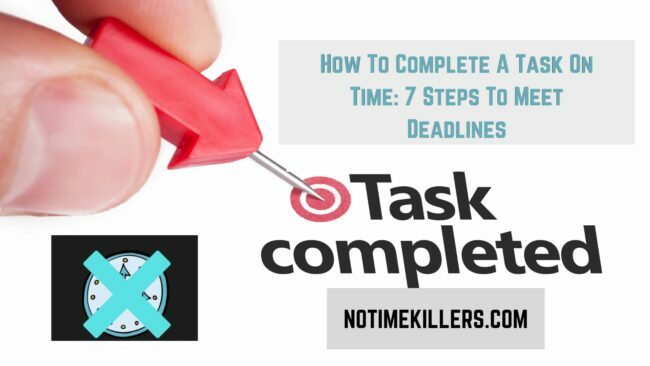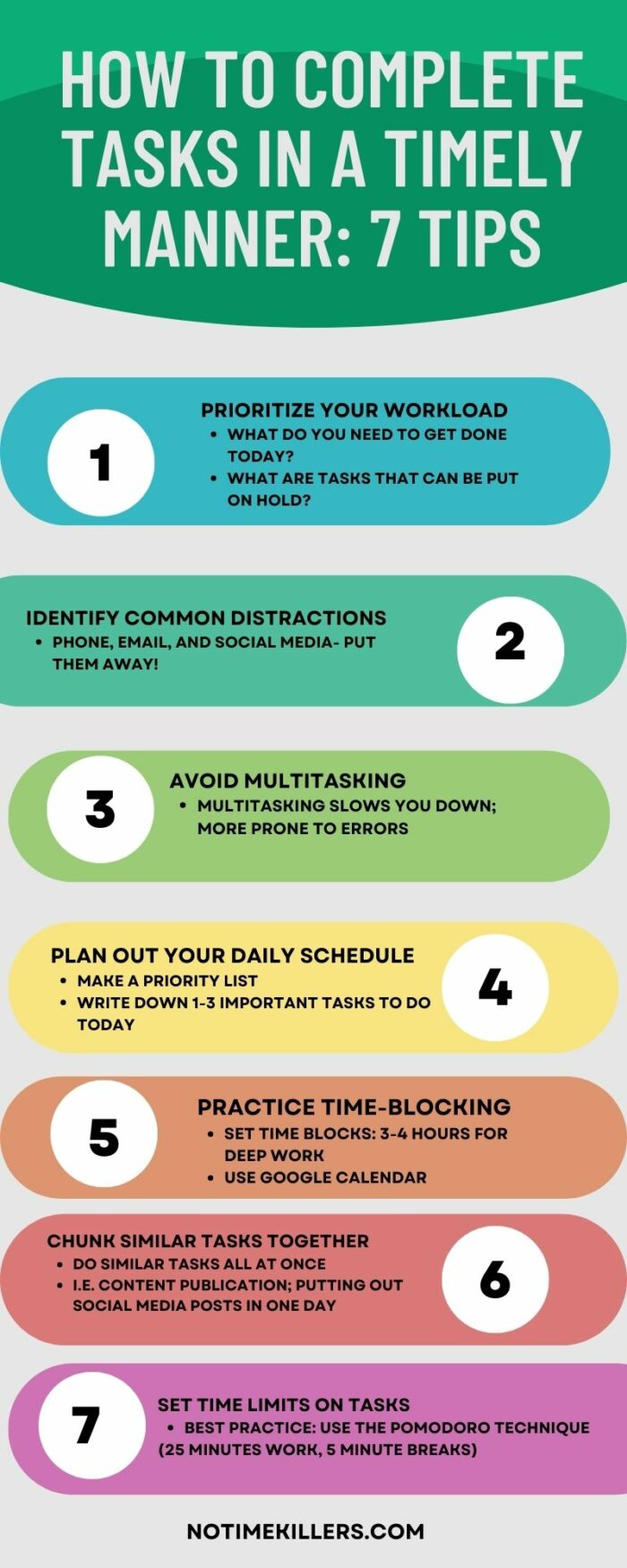Have you struggled to get any work done on time? Do you wish you knew how to complete a task on time?
If you’re a procrastinator, you’re scrambling to get stuff done soon. It’s not good when you’re disorganized and don’t know where to start.
In this article, I will discuss how I always complete my work on time. Along with that, I will lay out seven steps to help you meet deadlines more effectively.
- Prioritize Your Workload
- Identify Common Distractions
- Avoid Multitasking
- Plan Out Your Daily Schedule
- Practice Time Blocking
- Chunk Similar Tasks Together
- Set Time Limits On Tasks

Why do you always complete your work on time?
One quality to have is self-discipline, and that can be starting early before a looming deadline. Understand that the work has to get done sooner than later, so get used to prioritizing your tasks often.
If you’re able to discipline yourself and say something like:
“Hey, I need to get this project done in the next few days. If I wait to finish it the night before, I’m going to rush and feel more stressed at that time.”
So what needs to be done first and foremost? I find it very helpful to prioritize tasks accordingly. If you get used to doing that, it’ll be easier to get your work done on time.
Moreover, being disciplined and prioritizing your tasks can benefit you in getting work done on time. I find that it helps build confidence in my ability to work, while not feeling so overwhelmed most days.
How to complete a task on time
Completing a task on time can be challenging, but not always. It’s all about prioritizing your work, ignoring distractions, and working in set time blocks. Let’s go over some of these points further.

How to complete tasks in a timely manner
Let’s review some of the following tasks to complete when it’s needed the most. If you struggle with deadlines, take these steps into consideration.
Prioritize your workload
Prioritizing your tasks is crucial to working effectively. It’s good to ask yourself the following questions:
- What do I need to get done today?
- Are there projects that are due this week?
- What are tasks that can be put on hold?
For myself, I like taking the approach of which tasks need to get done sooner. Working in operations within previous jobs, we would follow a First In-First Out (FIFO) approach at work.
In other words, any mail that came in today had to be prioritized first, before looking at other mail for later in the day.
Especially if you have a heavy workload, prioritizing will help a lot. If you can master that down well, it’ll be easier to take on your workload.

Identify common distractions
While working on a task, notice if you get distracted at times. Some questions to ask yourself:
- Does your phone keep going off with notifications?
- Do you have your email opened up all the time?
- Are you popping in on social media?
If these things are grabbing your attention, then it’s time to limit your usage of electronics. These are great tools to leverage, but they can be huge productivity killers as well.
Best practice
Whenever doing deep work, put away all distractions that will take away your time. Lock up your phone in a drawer, and close your email and social media, while focusing on the tasks that you need to complete.

Avoid multitasking
It may be tempting, but multitasking doesn’t do you any favors. Instead of thinking you’ll get more done, it can slow you down more than you think.
According to one study, only 2.5% of individuals can effectively multitask. That’s a small number if you compared it to the world’s population.
It’s clear that people cannot multitask well. Driving is a good example of this. Doing multiple things while driving is not only risky but also slows us down.
With the effects of multitasking, you’re more prone to making mistakes and it can lower your productivity.
Along with that, we’re not able to learn effectively and stay focused for long periods of time. More so, multitasking is a no-no when working on more than one task.
Best practice
Work on single-tasking: Work on one task at a time. You’ll be more focused and feel that you’re performing your best.
A relevant article from notimekillers.com
Read next on “Does Multitasking Lower Productivity? Yes, It Does!“, to learn why multitasking slows down your overall productivity.

Plan out your daily schedule
Planning can help a lot, which saves you time as well. So planning (in essence) helps you save a whole lot of time.
Every minute you spend in planning saves 10 minutes in execution; this gives you a 1,000 percent Return on Energy!
Brian Tracy (Public speaker and personal development coach)
Based on that quote by Tracy, it’s a great return on investment time-wise. So it’s worth looking into, and seeing if it can save you a whole bunch of time later on.
How to go about it
When planning out my day, one question I ask myself is the following: What are the most important tasks (MITS) I need to get done today?
Usually, I’ll list between one-three tasks that need the most attention. Going more in-depth, here’s the approach I like to use for completing daily tasks:
a.) Make a priority list the night before (or the morning of).
b.) Write down one-three tasks that need to get done (these are my MITS).
c.) Once those tasks are done, list out other tasks you can do for the remainder of the day (If you have time- if not, then save them for another day)
How do I force myself to finish tasks?
Besides setting deadlines for yourself, changing your work environment can help if you’re easily distracted. Another thing you can do is reward yourself, such as having a small piece of candy or chocolate after doing a challenging task.
Practice time blocking
Time blocking is an effective approach to conducting deep work. The practice involves setting several time blocks during the day; for example, usually three-four hours of deep work daily.
It helps you know when to work on critical tasks that will take more time, and may need more attention.
For a better example of what I use, check out a post I wrote about a while back. I show how I used Google Calendar to schedule my time blocks.
Chunk similar tasks together
If tasks are related and can be done together, it may be best to do them all in one setting. It can help with planning other tasks to be done at other times.
For example, planning out your content publications monthly can save you an hour or two each week. Instead of planning every week, why not set aside one-two hours each month when your content should come out?
How it helps with my work schedule
I find chunking similar tasks into one setting helps save me a lot of time. Especially when it comes to planning social media posts, it helps a lot.
For instance, I’ll set aside one day each week to plan all my social media posts to go out the following week. Rather than do one post the day of, I get all the planning done within an hour each week.
It helps me manage my time better, and it makes me more efficient. With social media, not my biggest strength, I’d rather spend my time doing tasks that I’m good at, such as writing long-form articles.
Set time limits on tasks
For certain tasks, you need to set some limits and know when it has to get done. Instead of spending an entire day completing one large task (i.e. 12 hours), why not limit that to three hours top?
Some tasks are meant to take only a few hours to complete, and it can save you a lot of time as well. One of my favorite methods for doing deep work is the Pomodoro Technique.

How it works
In a nutshell, you work only on one task for 25 minutes, followed by a 5-minute break. You do that for four consecutive periods, followed by taking a longer break. It can range from 15 minutes to 30 minutes.
After that, you work on another task and go through the same cycle. From my experience, it’s very effective when done correctly.
If you prefer longer work periods, aim for 45 minutes, followed by 10-minute breaks. I’ve tried that before, and it works just as well with shorter work periods.
A relevant article from notimekillers.com
Read next on “How To Do The Pomodoro Technique: Is It Effective For Time? to learn how this technique can help you get more of your important tasks done.
Final Words
Completing a task on time is not that difficult. Learning to be more mindful of using your time can come a long way.
Do you want to be more effective in getting things done? The steps outlined earlier can help out getting more work done.
My personal suggestion to give out is to change your attitude and maintain self-discipline. Working on critical tasks won’t seem as challenging if you’re willing to change that part of yourself.
Your Turn: Can you complete tasks on time?
I would like to get your thoughts on this topic. Do you know how to complete certain tasks on time?
Have you struggled to meet deadlines before? Was it due to procrastination or a lack of motivation?
Which of the steps do you believe will help you complete tasks efficiently? Can prioritizing tasks make your workload easier?
Feel free to share your thoughts by leaving a comment below. I look forward to reading your responses, and I’ll gladly respond promptly.
If you got value from this article, please bookmark this website to visit later for new posts every week. Spread the word to others. Sharing is caring! To get more of this type of content, you won't want to miss out my daily email letters. These are worth some golden nuggets and best tips to help you in your business. Sign up today! Count me in on the daily letters via email! For the latest videos that come out every week, subscribe to the YouTube channel. Also, be sure to check out our new space on Twitter X! YouTube Twitter (X) Medium Profile
Eric is the owner and chief editor of notimekillers.com. He takes great pride in helping people manage their time and grow their businesses. Eric is a firm believer in financial and time freedom, as he believes in financial independence and taking ownership of your time. “Time is your most important asset. It can be your best friend or worst enemy. How you use your time can shape the future you desire to have.” In his leisure time, Eric loves to write and read whenever possible. He enjoys going for long walks outdoors while doing in-home workout videos every week. You can also connect with Eric via LinkedIn.


Maybe I am weird…but I hate being late (to appts or even if a work project is due), but I also procrastinate.
I feel like I work best under pressure…but I also have a lot of distractions in my life. Cue kids, pets, husband…
Also add in all of the people in my immediate family have ADHD (except for me), so I feel like I am trying to keep everyone else on schedule.
So, how do you manage that side of things? Part of the procrastination is due to scheduling everyone else and keeping them on task.
Hi Kelly,
Yes, I’ve felt that way before. I never like being late for anything, as that can throw off my day entirely.
Distractions are going to be inevitable. But there are ways to manage it, and once you do it, it’ll be easier to overcome them at times.
How I manage it is I set boundaries between myself and others. So when I need to do focus work, I’ll let people know that I need “me time” to do those complex tasks.
Also, putting away other things such as my phone- or not being on distracting websites as well. Those have helped me a lot as well.
If you’d like to learn more about how to approach it, I encourage you to check out a post I wrote a while back. It’s well worth reading.
Thank you very much for sharing your thoughts- they’re greatly appreciated.